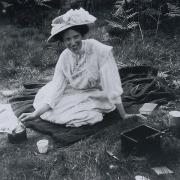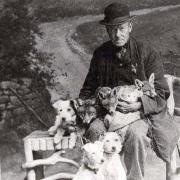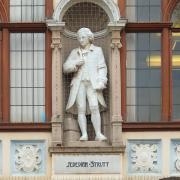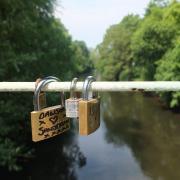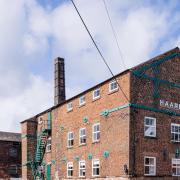Ladybower was the last of the Derwent Valley reservoirs to be completed in 1943, which was also the year it made history as the testing ground for the Dambusters. Mike Smith pays a visit
As historian Vic Hallam points out in his book ‘The Silent Valley at War’, 1943 was the most eventful year in the history of the Upper Derwent Valley. Ashopton Village, Derwent Hall and part of Derwent village were demolished to make way for Ladybower Reservoir, which had been completed after a ten-year construction period. As the waters began to rise, Lancaster bombers flew over the Howden and Derwent dams (which already existed in the higher reaches of the valley) in order for pilots to practise low-level bombing runs for the ‘Dambuster’ raids on the reservoirs of the Ruhr.
Seven decades later, only three of the 133 airmen who took part in the raids are still alive; very little of Derwent village remains and Birchinlee, the temporary ‘tin town’ built to house the workers who constructed the Howden and Derwent dams between 1902 and 1916, has been obliterated from the face of the earth. Hoping that I would find at least some trace of the momentous events of 1943 and a few reminders of life in the valley before that time, I set off in pursuit of the evidence.
My search began in the great castellated western tower of the Derwent dam, where Vic Hallam runs a wonderful museum crammed with archive photographs of the valley and mementoes of 617 Squadron, which carried out the audacious Dambuster raids under the leadership of Wing Commander Guy Gibson. The little museum contains a model of a Lancaster bomber and a full-scale replica of one of the famous ‘bouncing bombs’ designed by Barnes Wallis for use in the attacks. It also houses Roy Kitchener’s detailed models of the former villages of Derwent and Ashopton.
Recalling the opening of the museum in 1984,Vic said:‘My interest in the history of the dams was sparked by an archive collection of photographs held by my grandfather, who was employed as an engineer on the construction of the Howden and Derwent dams. When the museum first opened, there was nothing in it about the Dambusters because I had no material relating to them but, as chance would have it, three former members of 617 Squadron were on a nostalgic visit to the area on the day we opened. They suggested we should raise funds for a commemorative plaque and start an appeal for memorabilia. Since that time, artefacts of every description have flooded in.’
Over the years, Vic has met 41 members of the original squadron and has got to know the actor Richard Todd, who played Wing Commander Guy Gibson in the famous film of the Dambusters. Needless to say, the museum, which is open every Sunday, is extremely popular and Vic spends the entire day meeting and talking to visitors, many of whom add to his fund of knowledge about both 617 Squadron and the history of the Upper Derwent Valley. To date, Vic has written no fewer than four books on the basis of that ever-increasing knowledge.
After leaving the museum, I drove along the foot of the huge dam wall and crossed the valley floor to what remains of the village of Derwent. Vehicular access to the village by the general public is prohibited, but I had an appointment with William Middleton and Gary Woodhead, both of whom are members of Derwent and Hope Woodlands Parish Council and live in cottages that were allowed to remain in place after the flooding of the valley to make way for Ladybower Reservoir.
The village now sits in an idyllic location on the shores of the lake. With its picturesque cottages, red telephone box and its traffic-free meandering lane, Derwent looks like a throwback to the England of yesteryear. Derwent Hall, which stood alongside the village, was demolished when the reservoir was constructed, as was the village church, although its spire was allowed to protrude eerily out of the water for a time until it was dismantled on safety grounds. However, Derwent does still possess a village hall, which was built for the villagers by the Duke of Norfolk and is known as St Henry’s Hall.
Although Derwent now comprises only five occupied dwellings, with a total of seven residents, plus nearby farms and cottages with a further eight residents, the village hall is still a centre of social life. The Parish Council and the National Trust hold meetings there and the hall is a venue for children’s parties and for meetings of a women’s group called ‘The Belles’, whose name is a clever punning reference to a very special artefact that has found its way into St Henry’s Hall from Derwent Hall.
William Middleton lives with his wife Jane in the former lodge of Derwent Hall, a grand mansion built in 1673 by Henry Balguy and acquired in 1866 by the Duke of Norfolk, who added a private Roman Catholic chapel. William’s neighbour, Gary Woodhead, told me that the bell of the demolished chapel ended up in the yard of Bryan Dobson, a scrap merchant, but was rescued by his son Edward. After a period when it was displayed in the Marquis of Granby pub at Bamford, it is now on indefinite loan to the parishioners of Derwent and is housed in a display case in St Henry’s Hall.
The fate of another artefact from Derwent Hall is equally fascinating. The hall became a Youth Hostel in 1932, but was commandeered for use by evacuees from Sheffield’s Notre Dame School during the early years of the Second World War. It then reverted to its former use as a Youth Hostel until its demolition to make way for the reservoir. After the flooding of the valley, the Youth Hostel was rehoused in Castleton and compensated for its eviction from Derwent with a small gift in the form of a little statue called ‘Peeping Tom’, which once peered over the perimeter wall of the hall.
Alistair Boyd, who became warden of the Castleton Youth Hostel in 1986, told me that Peeping Tom was in the habit of sitting among the guests until he was removed from the hostel and loaned to the new visitor centre at Fairholmes on the shores of Ladybower Reservoir. The cheeky chap has since been returned to the Youth Hostel and is now housed in their latest premises at Losehill Hall, where he sits in the entrance and peers at the guests as they sign in.
On the way to visit Peeping Tom, I passed through the village of Hope, where I spotted a tin structure that is obviously a survivor from one of the many such buildings that were erected in the temporary village of Birchinlee, which housed construction workers on the Derwent and Howden reservoirs. Since its removal from the Derwent Valley to Hope, the building has been used as a saddler’s, a cobbler’s and a shoe shop. It is now a charming hairdressing and beauty salon.
My search for remains of the pre-1943 valley ended at Slippery Stones, a peaceful beauty spot in countryside beyond the uppermost dam at Howden, where an old packhorse bridge was re-erected to save it from submersion during the creation of Ladybower Reservoir. The peace of this enchanting place could well be shattered on May 16th, much as it was 70 years ago when the pilots of 617 Squadron practised their low-level flying manoeuvres. Although there are no formal plans for anniversary celebrations in the valley on that day, there is likely to be a noisy commemorative fly-past, including the unmistakable sight and sound of a Battle of Britain Memorial Flight Lancaster Bomber.
The Derwent Valley Museum, in the west tower of Derwent Reservoir, is open from 10am to 4pm on Sundays and Bank Holidays.




